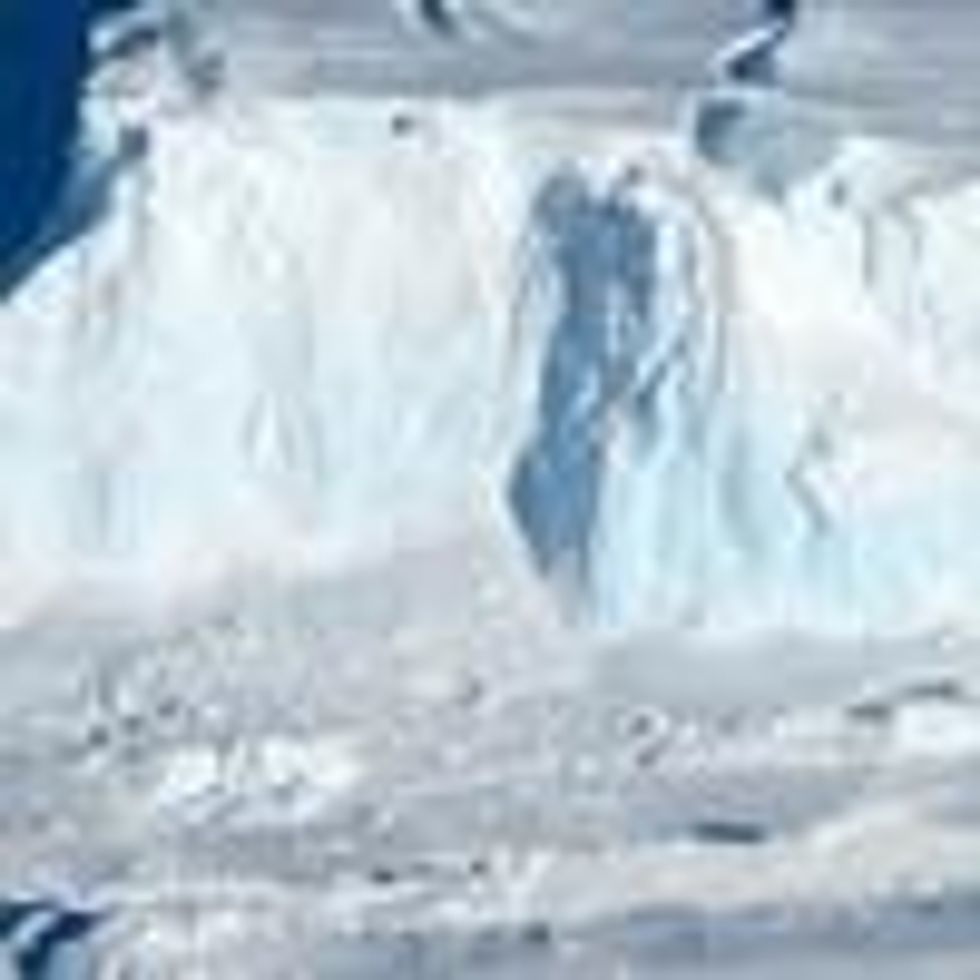
West Antarctica's massive Thwaites Glacier is often called "one of the world's most dangerous glaciers" because of its potential contributions to sea level rise. (Photo: James Yungel/NASA)
'Monster' Antarctic Glacier at Risk as Key Ice Shelf Faces Collapse Years Earlier Than Expected
"What we're seeing is already enough to be worried about," said one researcher.
The ice shelf holding back one of Antarctica's most perilous glaciers is eroding from below due to higher ocean temperatures, prompting scientists to warn Monday that this key reinforcement could shatter in the next three to five years--a development that would threaten millions of people with intensifying sea level rise.
"Until recently, the ice shelf was seen as the most stable part of Thwaites Glacier, a Florida-sized frozen expanse that already contributes about 4% of annual global sea level rise," the Washington Post reported. "Because of this brace, the eastern portion of Thwaites flowed more slowly than the rest of the notorious 'doomsday glacier.'"
However, recent satellite imagery shared during Monday's annual meeting of the American Geophysical Union shows numerous cracks that stretch diagonally across the surface of the floating ice wedge.
Comparing the newly discovered weaknesses to cracks in a windshield, Erin Pettit, a glaciologist at Oregon State University said that "this eastern ice shelf is likely to shatter into hundreds of icebergs."
\u201cNot the headline one most hopes to read...\nhttps://t.co/oOjO1TiakI\u201d— Bill McKibben (@Bill McKibben) 1639430343
According to the Post:
The failure of the shelf would not immediately accelerate global sea level rise. The shelf already floats on the ocean surface, taking up the same amount of space whether it is solid or liquid.
But when the shelf fails, the eastern third of Thwaites Glacier will triple in speed, spitting formerly landlocked ice into the sea. Total collapse of Thwaites could result in several feet of sea level rise, scientists say, endangering millions of people in coastal areas.
In 2019, a team of researchers estimated that the fossil fuel-driven climate crisis is putting Thwaites at increased risk of hitting a tipping point that could eventually cause sea levels to surge by 20 inches.
Related Content

Study Warns Melting of 'One of the World's Most Dangerous Glaciers' Could Cause 20-Inch Sea Level Rise
The Post reported Monday that even if the newly discovered fractures "don't cause the shelf to disintegrate, it is likely to become completely unmoored from the seafloor within the next decade" because "the warming ocean is loosening the ice shelf's grip on the underwater mountain that helps it act as a brace against the ice river at its back."
Other researchers from the International Thwaites Glacier Collaboration expressed concerns about the so-called "grounding zone," where the landed portion of the glacier meets the floating shelf, which juts out into the sea and undergoes an accelerated melting process due to relatively warmer water.
Scientists fear that if Thwaites were to lose its protective ice shelf, it "may become vulnerable to ice cliff collapse, a process in which towering walls of ice that directly overlook the ocean start to crumble into the sea," the Post noted.
Although this process has not yet been observed in Antarctica, University of St. Andrews glaciologist Anna Crawford has developed models indicating that Thwaites--which she called "kind of a monster"--is susceptible to ice cliff collapse, even if it is not likely to occur in the immediate future.
"What we're seeing is already enough to be worried about," said Crawford.
An Urgent Message From Our Co-Founder
Dear Common Dreams reader, The U.S. is on a fast track to authoritarianism like nothing I've ever seen. Meanwhile, corporate news outlets are utterly capitulating to Trump, twisting their coverage to avoid drawing his ire while lining up to stuff cash in his pockets. That's why I believe that Common Dreams is doing the best and most consequential reporting that we've ever done. Our small but mighty team is a progressive reporting powerhouse, covering the news every day that the corporate media never will. Our mission has always been simple: To inform. To inspire. And to ignite change for the common good. Now here's the key piece that I want all our readers to understand: None of this would be possible without your financial support. That's not just some fundraising cliche. It's the absolute and literal truth. We don't accept corporate advertising and never will. We don't have a paywall because we don't think people should be blocked from critical news based on their ability to pay. Everything we do is funded by the donations of readers like you. Will you donate now to help power the nonprofit, independent reporting of Common Dreams? Thank you for being a vital member of our community. Together, we can keep independent journalism alive when it’s needed most. - Craig Brown, Co-founder |
The ice shelf holding back one of Antarctica's most perilous glaciers is eroding from below due to higher ocean temperatures, prompting scientists to warn Monday that this key reinforcement could shatter in the next three to five years--a development that would threaten millions of people with intensifying sea level rise.
"Until recently, the ice shelf was seen as the most stable part of Thwaites Glacier, a Florida-sized frozen expanse that already contributes about 4% of annual global sea level rise," the Washington Post reported. "Because of this brace, the eastern portion of Thwaites flowed more slowly than the rest of the notorious 'doomsday glacier.'"
However, recent satellite imagery shared during Monday's annual meeting of the American Geophysical Union shows numerous cracks that stretch diagonally across the surface of the floating ice wedge.
Comparing the newly discovered weaknesses to cracks in a windshield, Erin Pettit, a glaciologist at Oregon State University said that "this eastern ice shelf is likely to shatter into hundreds of icebergs."
\u201cNot the headline one most hopes to read...\nhttps://t.co/oOjO1TiakI\u201d— Bill McKibben (@Bill McKibben) 1639430343
According to the Post:
The failure of the shelf would not immediately accelerate global sea level rise. The shelf already floats on the ocean surface, taking up the same amount of space whether it is solid or liquid.
But when the shelf fails, the eastern third of Thwaites Glacier will triple in speed, spitting formerly landlocked ice into the sea. Total collapse of Thwaites could result in several feet of sea level rise, scientists say, endangering millions of people in coastal areas.
In 2019, a team of researchers estimated that the fossil fuel-driven climate crisis is putting Thwaites at increased risk of hitting a tipping point that could eventually cause sea levels to surge by 20 inches.
Related Content

Study Warns Melting of 'One of the World's Most Dangerous Glaciers' Could Cause 20-Inch Sea Level Rise
The Post reported Monday that even if the newly discovered fractures "don't cause the shelf to disintegrate, it is likely to become completely unmoored from the seafloor within the next decade" because "the warming ocean is loosening the ice shelf's grip on the underwater mountain that helps it act as a brace against the ice river at its back."
Other researchers from the International Thwaites Glacier Collaboration expressed concerns about the so-called "grounding zone," where the landed portion of the glacier meets the floating shelf, which juts out into the sea and undergoes an accelerated melting process due to relatively warmer water.
Scientists fear that if Thwaites were to lose its protective ice shelf, it "may become vulnerable to ice cliff collapse, a process in which towering walls of ice that directly overlook the ocean start to crumble into the sea," the Post noted.
Although this process has not yet been observed in Antarctica, University of St. Andrews glaciologist Anna Crawford has developed models indicating that Thwaites--which she called "kind of a monster"--is susceptible to ice cliff collapse, even if it is not likely to occur in the immediate future.
"What we're seeing is already enough to be worried about," said Crawford.
The ice shelf holding back one of Antarctica's most perilous glaciers is eroding from below due to higher ocean temperatures, prompting scientists to warn Monday that this key reinforcement could shatter in the next three to five years--a development that would threaten millions of people with intensifying sea level rise.
"Until recently, the ice shelf was seen as the most stable part of Thwaites Glacier, a Florida-sized frozen expanse that already contributes about 4% of annual global sea level rise," the Washington Post reported. "Because of this brace, the eastern portion of Thwaites flowed more slowly than the rest of the notorious 'doomsday glacier.'"
However, recent satellite imagery shared during Monday's annual meeting of the American Geophysical Union shows numerous cracks that stretch diagonally across the surface of the floating ice wedge.
Comparing the newly discovered weaknesses to cracks in a windshield, Erin Pettit, a glaciologist at Oregon State University said that "this eastern ice shelf is likely to shatter into hundreds of icebergs."
\u201cNot the headline one most hopes to read...\nhttps://t.co/oOjO1TiakI\u201d— Bill McKibben (@Bill McKibben) 1639430343
According to the Post:
The failure of the shelf would not immediately accelerate global sea level rise. The shelf already floats on the ocean surface, taking up the same amount of space whether it is solid or liquid.
But when the shelf fails, the eastern third of Thwaites Glacier will triple in speed, spitting formerly landlocked ice into the sea. Total collapse of Thwaites could result in several feet of sea level rise, scientists say, endangering millions of people in coastal areas.
In 2019, a team of researchers estimated that the fossil fuel-driven climate crisis is putting Thwaites at increased risk of hitting a tipping point that could eventually cause sea levels to surge by 20 inches.
Related Content

Study Warns Melting of 'One of the World's Most Dangerous Glaciers' Could Cause 20-Inch Sea Level Rise
The Post reported Monday that even if the newly discovered fractures "don't cause the shelf to disintegrate, it is likely to become completely unmoored from the seafloor within the next decade" because "the warming ocean is loosening the ice shelf's grip on the underwater mountain that helps it act as a brace against the ice river at its back."
Other researchers from the International Thwaites Glacier Collaboration expressed concerns about the so-called "grounding zone," where the landed portion of the glacier meets the floating shelf, which juts out into the sea and undergoes an accelerated melting process due to relatively warmer water.
Scientists fear that if Thwaites were to lose its protective ice shelf, it "may become vulnerable to ice cliff collapse, a process in which towering walls of ice that directly overlook the ocean start to crumble into the sea," the Post noted.
Although this process has not yet been observed in Antarctica, University of St. Andrews glaciologist Anna Crawford has developed models indicating that Thwaites--which she called "kind of a monster"--is susceptible to ice cliff collapse, even if it is not likely to occur in the immediate future.
"What we're seeing is already enough to be worried about," said Crawford.

